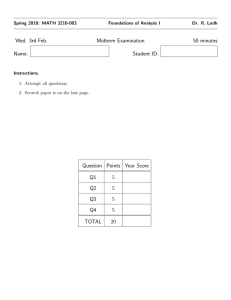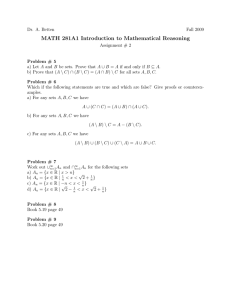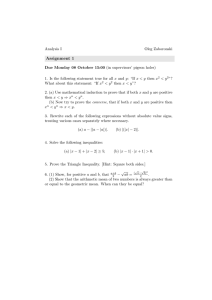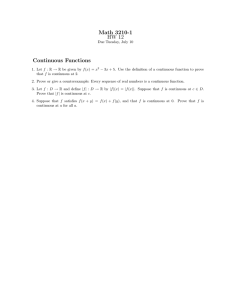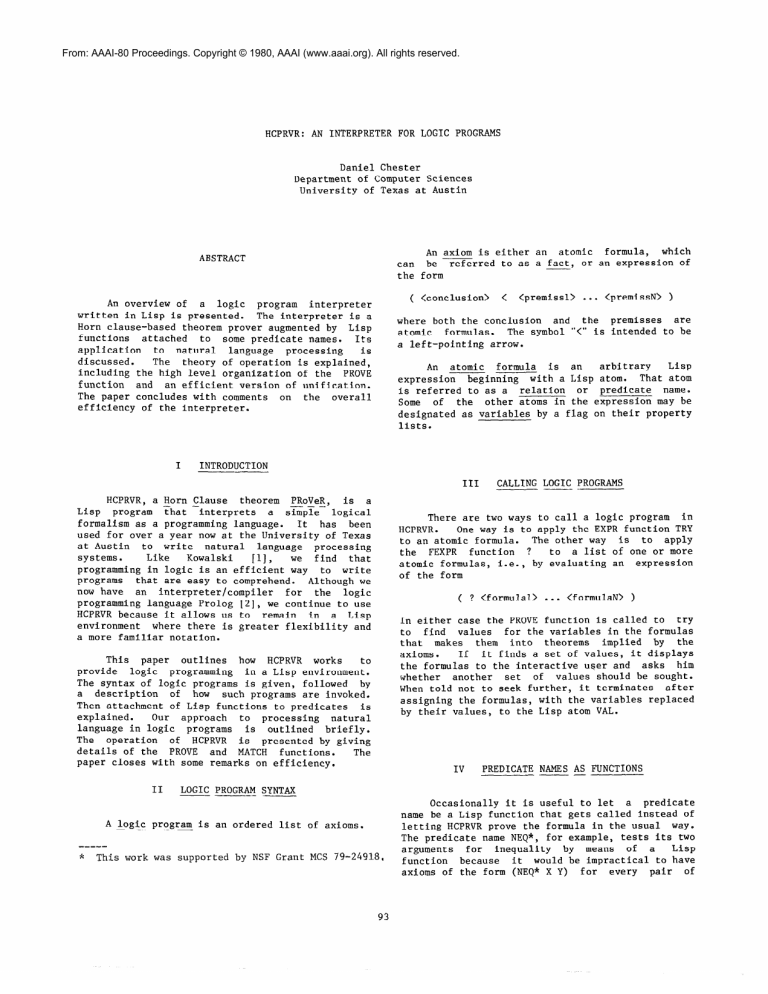
From: AAAI-80 Proceedings. Copyright © 1980, AAAI (www.aaai.org). All rights reserved.
HCPRVR:
AN INTERPRETER
FOR LOGIC
PROGRAMS
Daniel Chester
Department of Computer Sciences
University of Texas at Austin
which
An axiom is either an atomic
formula,
can
be referred to as a fact, or an expression of
the form
ABSTRACT
( <conclusion>
An overview of a logic
program
interpreter
written in Lisp is presented.
The interpreter is a
Horn clause-based
theorem prover augmented by Lisp
functions
attached
to some predicate names.
Its
application
to natural
language
processing
is
discussed.
The
theory of operation is explained,
including the high level organization
of the PROVE
function
and
an efficient version of unification.
The paper concludes with comments
on
the overall
efficiency of the interpreter.
I
)
Lisp
arbitrary
atom.
That atom
predicate
name.
expression may be
on their property
INTRODUCTION
LOGIC PROGRAM
~___--
LOGIC
PROGRAMS
--
( ? <formulal>
..- <formulaN>
>
In either case the PROVE function is called to try
for the variables in the formulas
to
find
values
implied
by
the
that
makes
them
into
theorems
If it finds a set of values, it displays
axioms.
asks
him
the formulas to the interactive user and
set
of values should be sought.
another
whether
When told not to seek further, it terminates
after
assigning the formulas, with the variables replaced
by their values, to the Lisp atom VAL.
IV
PREDICATE
NAMES AS FUNCTIONS
~-
SYNTAX
___
is an ordered
supported
-CALLING
There are two ways to call a logic program
in
One way is to apply the EXPR function TRY
HCPRVR.
The other way
is to apply
to an atomic formula.
the
FEXPR
function
?
to a list of one or more
atomic formulas, i.e., by evaluating an expression
of the form
This
paper
outlines
how HCPRVR
works
to
provide
logic
programming
in a Lisp environment.
The syntax of logic programs is given, followed
by
a description
of how
such programs are invoked.
Then attachment of Lisp functions to predicates
is
explained.
Our
approach
to processing
natural
language in logic
programs
is outlined
briefly.
The
operation
of HCPRVR
is presented by giving
details of the PROVE
and MATCH
functions.
The
paper closes with some remarks on efficiency.
-e--e
* This work was
.*. <premissN>
An ___
atomic
is an
-formula
expression
beginning
with a Lisp
or
is referred to as a relation
the other atoms in the
Some
of
designated as variables by a flag
lists.
III
A -logic program
<premissl>
are
the premisses
and
where both the conclusion
atomic
formulas.
The symbol "<" is intended to be
a left-pointing
arrow.
HCPRVR, a Horn Clause
theorem
PRoVeR,
is a
--Lisp
program
that -interprets
a simple
logical
formalism as a programming language.
It has
been
used for over a year now at the University of Texas
at Austin
to write
natural
language
processing
Like
systems.
Kowalski
we
find
that
[II,
programming
in logic is an efficient way
to write
programs
that are easy to comprehend.
Although we
now have
an interpreter/compiler
for
the
logic
programming
language Prolog [2], we continue to use
HCPRVR because it allows us to remain
in a Lisp
environment
where there is greater flexibility and
a more familiar notation.
II
<
list of axioms.
by NSF Grant MCS 74-2491
-8.
93
Occasionally
it is useful to let a predicate
name be a Lisp function that gets called instead of
letting HCPRVR prove the formula in the usual
way.
The predicate name NEQ*, for example, tests its two
Lisp
arguments
for
inequality
by means
of a
it would be impractical to have
function
because
axioms of the form (NEQ* X Y) for
every
pair
of
(S (THE CAT IS ON THE MAT)
(IS ACTOR (CAT DET THE)
LOC (ON LOC (MAT DET THE)))
NIL)
constants X and Y such that X does
equal
Y.
not
Predicate
names that are also functions are FEXPRs
and expect that their arguments have been
expanded
into
lists
in which all bound variables have been
replaced by their values.
These
predicate
names
must
be marked
as
functions
by having the Lisp
property
FN set
to
T,
executing
e.g.,
(PUT '<predicate name> 'FN T),
so thi: HCPRVR will
interpret them as functions.
VI
A.
General
THEORY
--
OF OPERATION
Organization
HCPRVR
works
essentially
by
the
problem
reduction
principle.
Each
atomic formula can be
thought of as a problem.
Those
that
appear
as
facts in the list of axioms represent problems that
have
been
solved,
while
those
that
appear
as
conclusions
can be reduced to the list of problems
represented by the premisses.
Starting
from
the
formula
to be proved, HCPRVR reduces each problem
to lists of subproblems and then
reduces
each
of
the
subproblems
in turn until they have all been
reduced to the
previously
solved
problems,
the
"facts"
on
the axiom list.
The key functions in
HCPRVR that do all this are PROVE and MATCH.
B.
By letting syntactic categories be predicates
with
three arguments, we can make axioms that pull
phrases off of a list
of words
until
we
get
a
sentence
that
consumes
the whole
list.
In
addition, arbitrary tests can be performed
on
the
phrase representations
to check whether they can be
semantically
combined.
phrase
Usually
the
representation
in the conclusion part of an axiom
tells
how
component
the
are
representations
combined,
while
the premisses tell how the phrase
should be factored into the component phrases, what
their'
representations
should
be,
and
what
restrictions
they have.
Thus, the axiom
((S X (U ACTOR
( <list
V . W) Z) < (NP X V Y)
(VP Y (U . W) Z)
(NUMBER v ~1)
(NUMBER U N2)
(EQ N1 N2))
( ( ( <formula>
list>
) NIL
)
of
the
binding
in the
values.
begins
) )
The algorithm of PROVE
works
in depth-first
fashion,
solving
subproblems
in
the
same
left-to-right
order as they occur in the axioms and
the axioms as problem reduction rules in
applying
the same order as they are listed.
PROVE begins by
examining
the
first
subproblem
structure on its
stack.
If the
list
of subproblems
in
that
structure
PROVE
either
returns
is empty,
the
binding list, if there are no other
structures
on
the
stack,
i.e., if the original problem has been
solved, or removes the
first
structure
from
the
stack and examines the stack again.
If the list of
subproblems of the first
structure
is
subproblem
not
PROVE examines the first subproblem on
__
empty,
the list.
If the
predicate
name
in it is a
function, the function is applied to the arguments.
If the function returns NIL, PROVE fails; otherwise
the
subproblem
is removed from the list and PROVE
begins all over again with the modified structure.
axioms have
been
stored,
the
IS ON THE MAT can be parsed by
of this computation
of subproblems>.<binding
where the list of subproblems is a sublist
premisses
in some axiom and the CAR of the
list is a list
of variables
occurring
subproblems,
paired
with
their
assigned
When PROVE is initially called by TRY,
it
with the stack
(? (S (THE CAT IS ON THE MAT) x NIL)
The result
Function
PROVE
is the
function
that
controls
the
problem
reduction process.
It has one argument, a
stack of subproblem
structures.
Each
subproblem
structure has the following format:
an
initial segment of word list X is a
says
that
sentence if first there is a noun
phrase
ending
where word list Y begins, followed by a verb phrase
ending where word list Z begins, and
both
phrases
agree in number (singular or plural).
Furthermore,
the noun phrase representation
V is made the actor
of
the verb U in the verb phrase, and the rest of
the verb phrase representation,
W, is carried along
in the representation
for the sentence.
After suitable
sentence
THE
CAT
typing
The PROVE
-~
is the theorem
94
When
the predicate
name
of
the
first
subproblem
in the
list
in the first subproblem
the
stucture is not a function,
all
PROVE
gets
axioms
that
are
stored under that predicate name
this
and assigns them to the local variable Y. At
point
PROVE
goes into a loop in which it tries to
apply each axiom in turn until one
is found
that
leads
to a solution to the original problem.
It
does this by calling the MATCH function to compare
the
conclusion
of
an axiom
the first
with
subproblem.
If the match fails, it tries the next
axiom.
If the match succeeds, the first subproblem
is removed from
the
first
subproblem
structure,
then a new subproblem structure is put on the stack
subproblem
in front of that structure.
This
new
structure
consists
of
the list of premisses from
the axiom and the binding list that was created
at
the time MATCH was called.
Then PROVE calls itself
with this newly formed stack.
If this call returns
a binding
list,
it
is returned as the value of
PROVE.
If the call
returns
NIL,
everything
is
restored
to what
it was
before
the axiom was
applied and PROVE tries to apply the next axiom.
The
value
of a variable is also a pair:
the term
that will replace the variable and the binding list
term.
The
binding
list
associated
with
the
associated with the term is used to find the values
of variables
occurring
in the term when needed.
Notice that variables do not have
to be
renamed
because MATCH is always called (initially) with two
identities
distinct binding lists, giving distinct
to
the variables
in the
two expressions to be
occurs
in
matched, even if the same variable name
both of them.
MATCH assigns a value to a variable by CONSing
it
to the CAR of the variable's binding list using
the RPLACA function; it also puts that binding list
on
the
list
bound
to the Lisp variable SAVE in
PROVE.
This is done so-that the effects
of MATCH
can be undone when PROVE backtracks to recover from
a failed application of an axiom.
VII
The way that PROVE applies an axiom
might
be
better
understood
by considering
the
following
illustration.
Suppose that the
stack
looks
like
this:
( ( (Cl C2).<blist>
HCPRVR
is surprisingly
efficient
for
its
simplicity.
The
compiled code fits in 2000 octal
words of binary programming space and runs as fast
the Prolog interpreter.
Although the speed can
t:
further
improved
by
more
sophisticated
programming,
we have
not
done
so because it is
adequate for our
present
needs.
A version
of
HCPRVR
has been written in C; it occupies 4k words
on a PDP11/60 and appears to run about half as fast
as the compiled Lisp version does on a DEC KIlO.
) ..* )
The
first
subproblem
in the
first
subproblem
structure is Cl. Let the axiom to be applied be
(C < Efl P2 P3)
PROVE applies it by creating
a new
binding
list
blist',
initially
empty, and then matching C with
Cl with the call (MATCH C <blist'> Cl <blist>).
If
this
call
is successful,
the following stack is
formed:
( ( (Pl P2 P3).<blist'>
)
( (C2).<blist>
The most important kind of efficiency we have
noticed,
however,
is
program
development
efficiency,
the ease with which logic programs
can
be written
and debugged.
We have found it easier
to write natural
language
processing
systems
in
logic
than
in any other formalism we have tried.
Grammar rules can be easily written as axioms, with
an
unrestricted
mixture
of
syntactic
and
Furthermore,
the same
non-syntactic
computations.
grammar rules can be used for parsing or generation
of sentences with no change in the algorithm
that
applies
them.
Other
forms
of natural language
processing are similarly easy to program in logic,
including
schema instantiation,
question-answering
and text summary.
We have found HCPRVR very useful
for gaining experience in writing logic programs.
) e.. )
Thus problem Cl has been reduced to problems Pl, P2
the binding list blist'.
and
P3 as modified
by
PROVE now applies PROVE to this stack in the hope
that all the subproblems in it can be solved.
cc>,
stack
In the event that the axiom to be applied
is
that
is,
the axiom is just a fact, the new
that is formed is
( ( ().<blist'>
)
( (C2).<blist>
) . .. )
it removes
When PROVE is called with this
stack,
the first subproblem stucture and begins working on
problem C2.
c.
The MATCH
--
EFFICIENCY
REFERENCES
The MATCH
function
is a version
of
the
unification
algorithm
that
has
been modified so
that renaming of variables
and
substitutions
of
variable
values
back
into
formulas are avoided.
The key idea is that the identity of a variable
is
determined
by both
the variable
name
and
the
binding list on which its value
will
be
stored.
95
"Algorithm
=
R.
A.
logic
CACM 22, 7, July, 1979, 424-436.
[l]
Kowalski,
control."
[2]
Pereira,
and F.
Warren,
D.
H.,
L.
M.
Pereira.
language
and
its
"PROLOG
- the
Proc.
implementation
compared
with
lisp."
AI -___
and Prog.
Langs.,
SIGPLAN
12,
SymP'
8/sIGARTx4,
August, 1977, 109-115.
Function
+

